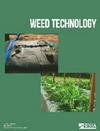水稻对不同施药量和施药时间的苯醚甲环唑反应
IF 1.7
3区 农林科学
Q3 AGRONOMY
引用次数: 0
摘要
目前,加州水稻可用的除草剂数量有限,而且大多数除草剂都普遍存在抗药性。由于没有抗性禾本科植物表现出对戊唑醇的抗性,因此进行了一系列研究,以评估水播稻对戊唑醇的反应。2020 年和 2021 年,加利福尼亚州比格斯水稻试验站进行了一项田间研究,在水稻播种后 5、10 和 15 天,分别以 1.1、2.3 和 3.4 kg ai ha-1 的剂量施用颗粒剂 (GR)、乳油 (EC) 和胶囊悬浮剂 (CS)。此外,还进行了一项温室研究,考察五种常见加州水稻品种对 GR 和 CS 制剂施用的反应。与较早的时间相比,在播种后 15 天使用 EC 和 CS 制剂后,Echinochloa 的控制水平有所降低。与播种后 5 天和 10 天施用 3.4 kg ai ha-1 的戊唑醇相比,在播种后 15 天施用 3.4 kg ai ha-1 的戊唑醇,水稻产量在这两年都增加了 3,014 kg ha-1,与 1.1 kg ai ha-1 的施用量相近。与 EC 相比,GR 和 CS 是更安全的制剂,因为它们减少了伤害,提高了谷物产量。施用戊唑醇后,不同栽培品种幼苗活力的差异似乎会带来优势。不过,大多数栽培品种在水稻长到 3 叶期后才会表现出对 GR 和 CS 制剂施用的耐受性,以减少立枯病和干生物量。相比之下,在水稻 1 叶期施药可使立秆率降低 68%。如果要在水稻中使用戊唑醇,施用量、施用时间和配方都是需要考虑的重要因素。本文章由计算机程序翻译,如有差异,请以英文原文为准。
Water-Seeded Rice Response to Pendimethalin Applied at Different Rates and Timings
Currently, there is a limited number of herbicides available in California water-seeded rice, with widespread resistance to most of these herbicides. Because no resistant grasses showed resistance to pendimethalin, a series of studies were conducted to evaluate water-seeded rice response to pendimethalin. In a field study conducted at the Rice Experiment Station at Biggs, California, in 2020 and 2021, three pendimethalin formulations, a granule (GR), emulsifiable concentrate (EC), and capsule suspension (CS), were applied at 1.1, 2.3, and 3.4 kg ai ha-1 rates, and at 5, 10, and 15 days after seeding onto water-seeded rice. In addition, a greenhouse study was conducted to examine the response of five common California rice cultivars to GR and CS formulation applications. Echinochloa control levels were reduced at the 15 days after seeding timing after use of EC and CS formulations compared to earlier timings. In both years, rice grain yields were increased by 3,014 kg ha-1 after application of pendimethalin at 3.4 kg ai ha-1 when applied at 15 days after seeding compared to 5 and 10 days after seeding, and similar to 1.1 kg ai ha-1 applications. The GR and CS were safer formulations based on a reduction in injury and an increase in grain yields compared to the EC. Differences in seedling vigor across cultivars appeared to incur an advantage after a pendimethalin application. However, most cultivars evaluated for stand reduction and dry biomass demonstrated tolerance to GR and CS formulation applications only after rice reached the 3-leaf stage. In contrast, an application at 1-leaf stage rice reduced stand up to 68%. Application rate, timing, and formulation are important factors to consider if the use of pendimethalin in water-seeded rice is to be pursued.
求助全文
通过发布文献求助,成功后即可免费获取论文全文。
去求助
来源期刊

Weed Technology
农林科学-农艺学
CiteScore
2.90
自引率
21.40%
发文量
89
审稿时长
12-24 weeks
期刊介绍:
Weed Technology publishes original research and scholarship in the form of peer-reviewed articles focused on understanding how weeds are managed.
The journal focuses on:
- Applied aspects concerning the management of weeds in agricultural systems
- Herbicides used to manage undesired vegetation, weed biology and control
- Weed/crop management systems
- Reports of new weed problems
-New technologies for weed management and special articles emphasizing technology transfer to improve weed control
-Articles dealing with plant growth regulators and management of undesired plant growth may also be accepted, provided there is clear relevance to weed science technology, e.g., turfgrass or woody plant management along rights-of-way, vegetation management in forest, aquatic, or other non-crop situations.
-Surveys, education, and extension topics related to weeds will also be considered
 求助内容:
求助内容: 应助结果提醒方式:
应助结果提醒方式:


